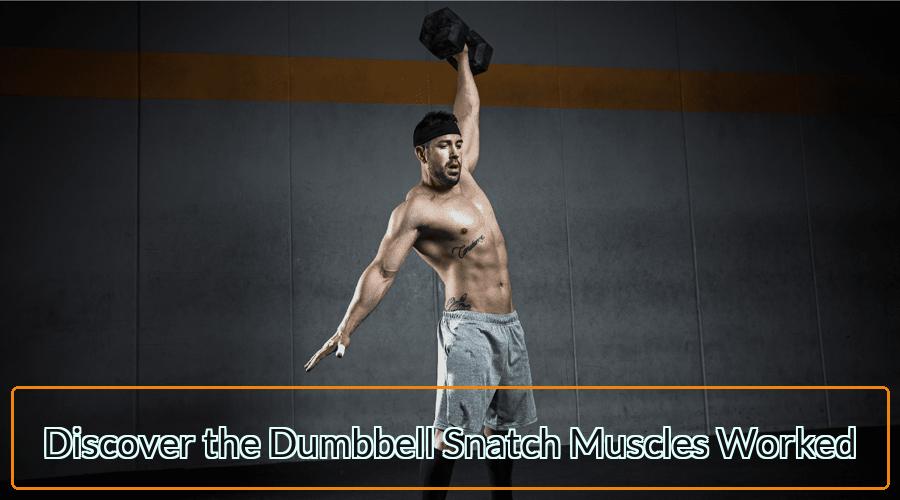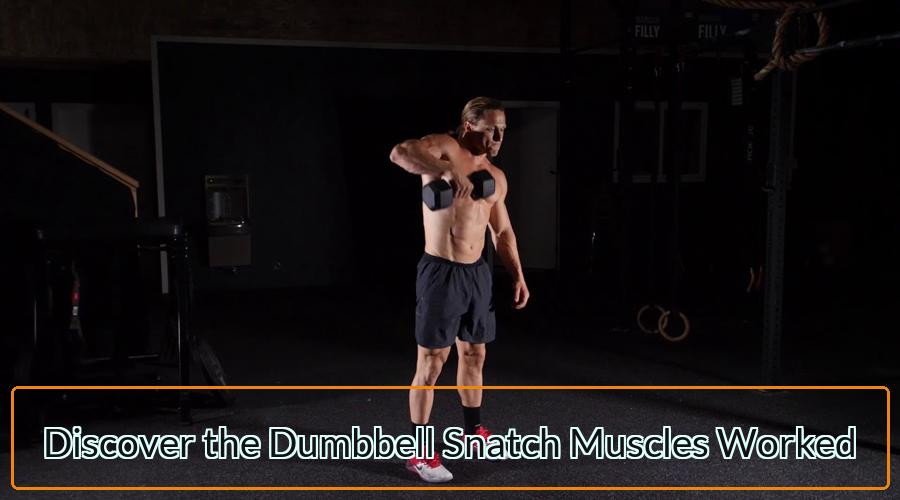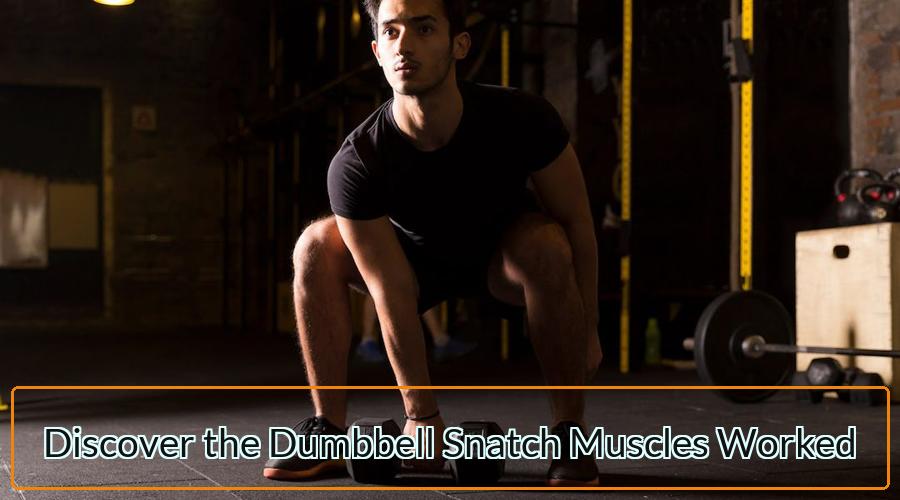
Have you ever wondered if there was a single exercise that could target multiple muscles at once? Look no further than the dumbbell snatch. This exercise, which involves a combination of a squat and a single-arm snatch, is a full-body movement that engages several muscle groups simultaneously.
In this post, we’ll take a deep dive into the dumbbell snatch and the muscles it works. From the benefits of incorporating this exercise into your routine to proper form and technique, we’ll cover everything you need to know to get the most out of this exercise.
Whether you’re a seasoned fitness enthusiast or a beginner looking to improve your strength and overall fitness, understanding the muscles worked in the dumbbell snatch is essential. So grab a dumbbell and let’s get started on this ultimate guide to the dumbbell snatch and the muscles it targets.
Definition of Dumbbell Snatch
The dumbbell snatch is a full-body exercise that involves lifting a weight from the ground to an overhead position in one smooth and explosive movement. It typically involves a combination of a squat and a single-arm snatch, with the weight being lifted from the ground to the shoulder level and then overhead in a continuous motion. This exercise is often used in weightlifting, CrossFit, and functional fitness workouts to improve strength, power, and overall fitness.
Importance of Knowing the Muscles Worked
Knowing the muscles worked in an exercise like the dumbbell snatch is important for several reasons. First, it helps you to understand how exercise can benefit your overall fitness goals. By targeting specific muscle groups, you can improve your strength, power, and endurance in those areas. Second, understanding the muscles worked can help you to properly execute the exercise with the correct form and technique, reducing the risk of injury and maximizing the effectiveness of the movement. Finally, knowing the muscles worked can help you to create a well-rounded workout routine that targets all major muscle groups for balanced fitness and improved overall health.
Read more about 45 Minute Treadmill Workout
Primary Dumbbell Snatch Muscles Worked
Glutes
The glutes are the largest and most powerful muscles in the human body, and they play a crucial role in the dumbbell snatch exercise. As you lift the weight from the ground to the overhead position, your glutes are responsible for generating the explosive power needed to drive the weight upward. Additionally, your glutes help to stabilize your hips and lower body during the movement, which is important for maintaining proper form and reducing the risk of injury.
To maximize the activation of the glutes during the dumbbell snatch, it’s important to focus on using proper form and engaging the muscles throughout the entire movement. This means initiating the lift with a powerful hip extension, squeezing the glutes at the top of the movement, and maintaining tension in the muscles throughout the lowering phase.
Hamstrings
The hamstrings, located on the back of the thighs, are another important muscle group targeted by the dumbbell snatch. These muscles work in conjunction with the glutes to generate power and momentum during the lift, and they also help to stabilize the knee joint during the movement.
To activate the hamstrings during the dumbbell snatch, focus on initiating the lift with a powerful hip hinge, keeping the back straight and the knees slightly bent. This will help to engage the muscles in the back of the legs and prevent the weight from pulling you forward.
Quads
The quads, or quadriceps muscles, are located on the front of the thighs and play an important role in the dumbbell snatch exercise. These muscles help to extend the knee joint during the lift, providing additional power and stability to the movement.
To target the quads during the dumbbell snatch, focus on keeping the knees slightly bent throughout the movement and driving the weight upward with a strong leg extension. You can also add additional emphasis to the quads by performing the exercise with a wider stance, which will require greater activation of the muscles in the front of the thighs.
Shoulders
The shoulders are one of the primary muscles worked in the dumbbell snatch, as they are responsible for lifting the weight from the shoulder level to the overhead position. This requires a combination of shoulder abduction, external rotation, and scapular retraction, all of which are important for proper shoulder health and function.
To activate the shoulders during the dumbbell snatch, focus on initiating the lift with a strong shrug and maintaining tension in the muscles throughout the movement. You can also vary the grip on the dumbbell to target different areas of the shoulders, such as performing the exercise with a neutral grip for greater emphasis on the anterior deltoids.
Back muscles
The back muscles, including the lats, traps, and erector spinae, are also heavily involved in the dumbbell snatch exercise. These muscles help to stabilize the spine and upper body during the lift, and they also contribute to the explosive power needed to lift the weight from the ground to the overhead position.
To target the back muscles during the dumbbell snatch, focus on maintaining a strong, stable torso throughout the movement and engaging the muscles in the upper back and shoulders. You can also add additional emphasis to the lats by using a wider grip on the dumbbell and pulling the weight close to the body during the lift. Overall, the dumbbell snatch is an excellent exercise for targeting multiple muscle groups at once and improving overall strength, power, and fitness.
Read more about Trenbolone Pills for Sale
Secondary Dumbbell Snatch Muscles Worked
Triceps
The triceps, located on the back of the upper arm, are secondary dumbbell snatch muscles worked. These muscles play an important role in extending the elbow joint and stabilizing the arm during the lift, which is necessary for maintaining proper form and preventing injury.
To target the triceps during the dumbbell snatch, focus on maintaining a strong, stable upper arm throughout the movement and engaging the muscles in the back of the arms as you extend the elbow joint. You can also vary the grip on the dumbbell to add additional emphasis to the triceps, such as using a neutral grip or an underhand grip.
Biceps
The biceps, located on the front of the upper arm, are also secondary muscles worked during the dumbbell snatch. While these muscles are not the primary movers during the lift, they play a supporting role in stabilizing the arm and helping to control the weight during the lowering phase.
To activate the biceps during the dumbbell snatch, focus on maintaining tension in the muscles throughout the movement and using proper form and technique. You can also add additional emphasis to the biceps by performing the exercise with an underhand grip or by incorporating additional bicep-specific exercises into your workout routine.
Core muscles
The core muscles, including the rectus abdominis, obliques, and lower back muscles, are essential for maintaining proper form and stability during the dumbbell snatch exercise. These muscles help to transfer power from the lower body to the upper body, which is necessary for generating the explosive force needed to lift the weight from the ground to the overhead position.
To activate the core muscles during the dumbbell snatch, focus on maintaining a strong, stable torso throughout the movement and engaging the muscles in the abs and lower back. This means keeping the core tight and braced throughout the lift, and avoiding excessive arching or rounding of the spine. You can also incorporate additional core-specific exercises into your workout routine to further strengthen these muscles and improve overall stability and balance.

Benefits of Dumbbell Snatch
The dumbbell snatch is an excellent exercise that provides a wide range of benefits for those looking to improve their overall fitness and strength. Here are some of the key benefits of incorporating the dumbbell snatch into your workout routine:
- Increased strength and power: The dumbbell snatch is a full-body exercise that engages multiple muscle groups at once, including the glutes, hamstrings, quads, shoulders, and back muscles. By targeting these muscles simultaneously, the dumbbell snatch can help to increase overall strength and power, allowing you to lift heavier weights and perform other exercises with greater ease.
- Improved cardiovascular health: The dumbbell snatch is a high-intensity exercise that elevates the heart rate and increases oxygen consumption. This can lead to improved cardiovascular health, increased endurance, and greater overall fitness.
- Efficient use of time in the gym: Because the dumbbell snatch targets multiple muscle groups at once, it is an efficient exercise that can help you to make the most of your time in the gym. By incorporating the dumbbell snatch into your workout routine, you can work multiple muscle groups in a single exercise, saving time and maximizing your results.
- Versatility for athletes and fitness enthusiasts: The dumbbell snatch is a popular exercise among weightlifters, CrossFit athletes, and other fitness enthusiasts due to its versatility and ability to be modified to suit different fitness levels and goals. Whether you’re looking to improve your strength, power, or overall fitness, the dumbbell snatch can be adapted to meet your specific needs.
Overall, the dumbbell snatch is an excellent exercise that provides a wide range of benefits for those looking to improve their strength, power, and overall fitness. By incorporating this exercise into your workout routine and focusing on proper form and technique, you can maximize the benefits and achieve your fitness goals more efficiently and effectively.

Conclusion
The dumbbell snatch is a highly effective exercise that targets multiple muscle groups at once, providing a range of benefits for those looking to improve their overall fitness and strength. By understanding the primary and secondary muscles worked in the dumbbell snatch, as well as the benefits of this exercise, you can create a well-rounded workout routine that maximizes your results and helps you achieve your fitness goals.
Whether you’re a seasoned athlete or a beginner looking to improve your strength and power, the dumbbell snatch can be adapted to meet your specific needs and goals. By incorporating this exercise into your workout routine and focusing on proper form and technique, you can improve your cardiovascular health, increase your overall strength and power, and make the most of your time in the gym.
Overall, the dumbbell snatch is a versatile and effective exercise that should be a part of any well-rounded fitness routine. So grab a dumbbell and get started on your path to greater strength, power, and fitness today!